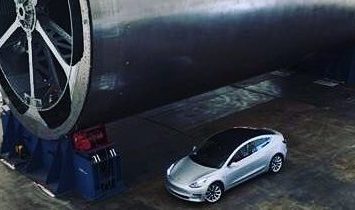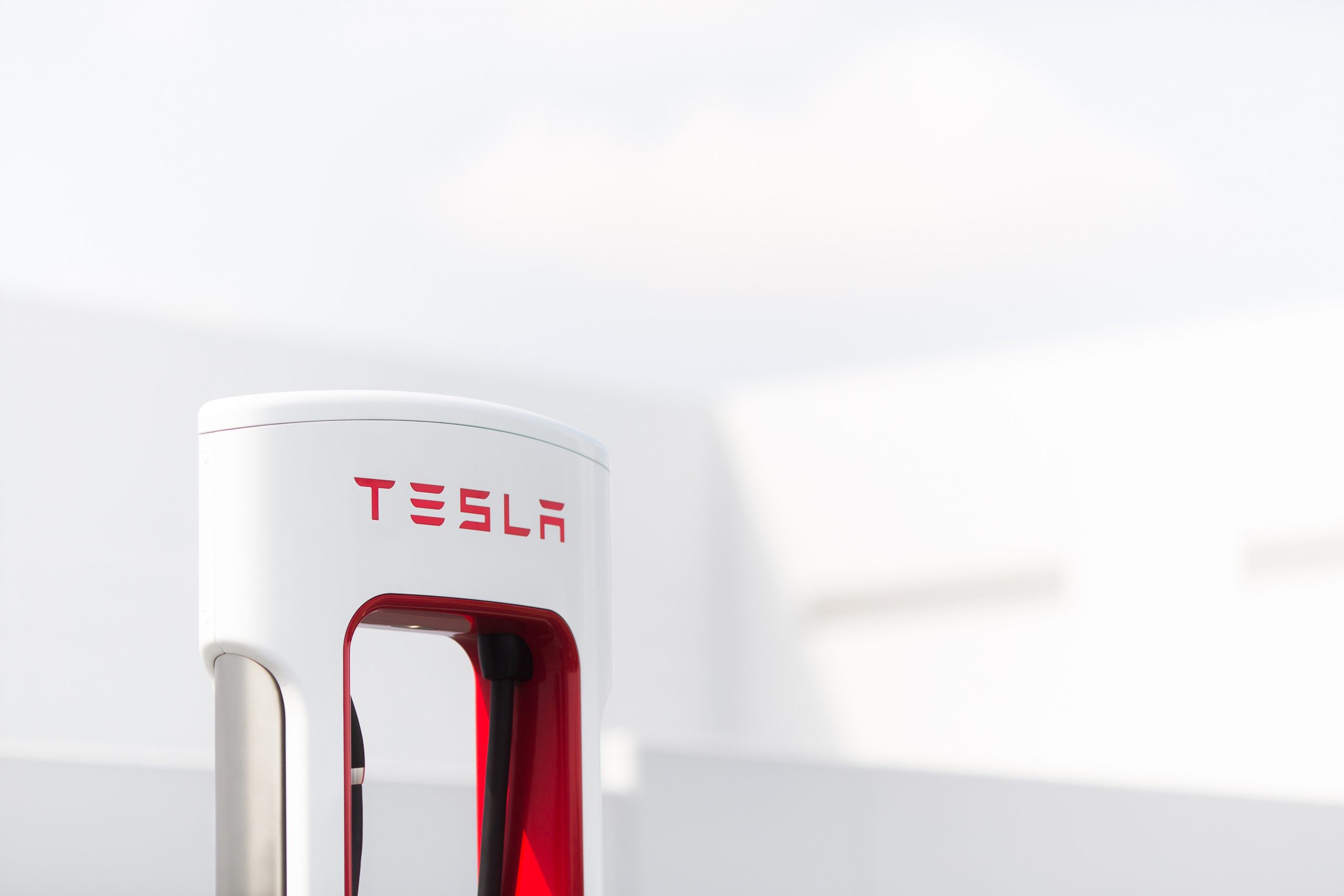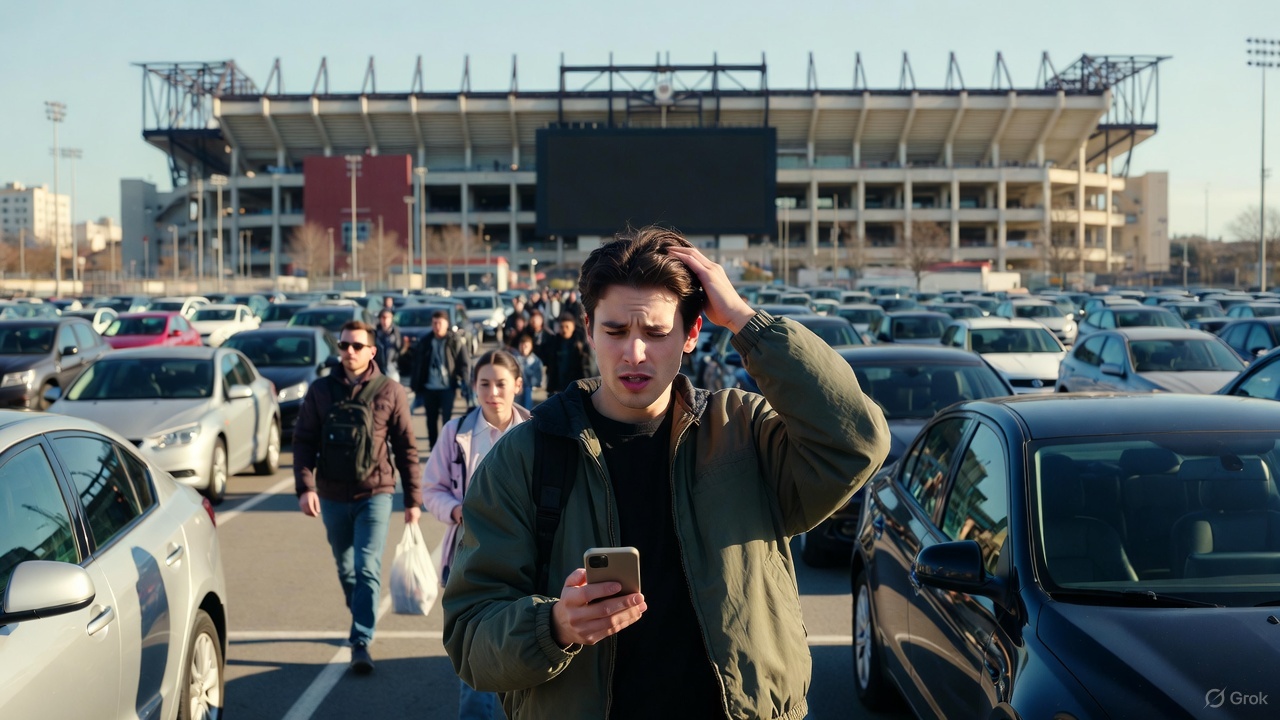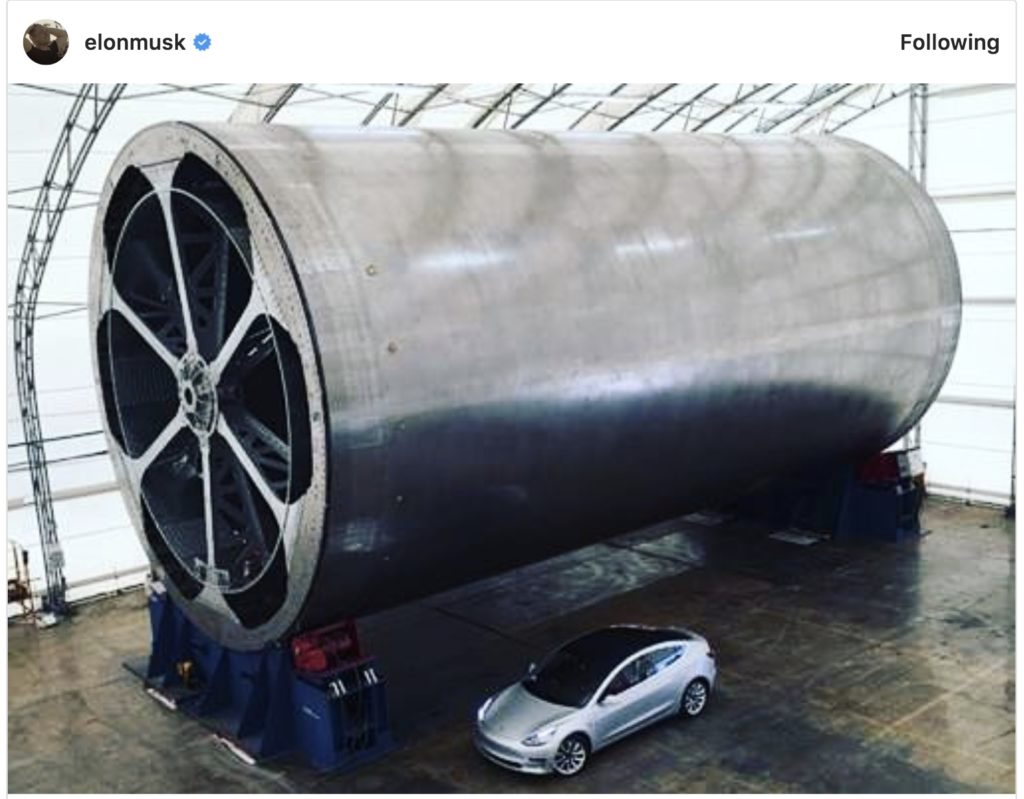

News
SpaceX Mars rocket tooling dwarfs Tesla Model 3 in new Elon Musk teaser
SpaceX CEO Elon Musk has published the first public photo of fabrication tooling intended to enable the construction of the first full-scale Mars spaceship prototype.
The massive cylinder revealed in Musk’s Instagram post – while not an actual rocket component – is a mold that will be used to carefully craft the carbon composite structures that are expected to be liberally used throughout SpaceX’s Mars rocket boosters and spaceships.
Building on a history of R&D with the contractor, SpaceX has likely procured this unique tooling from the Seattle-based Janicki Industries, previously known for their work on the jaw-dropping ITS oxygen tank that was revealed in 2016 and tested to failure in 2017. This time around, however, SpaceX is not simply contracting Janicki to construct a prototype tank at their Seattle facilities – rather, the company is acquiring the tools they will need to build their own massive carbon composite structures.
Combined with several other specialized components either not present or difficult to make out in the low resolution teaser image, the tool pictured will, sooner than later, slowly spin thousands of times, winding thin threads of carbon fiber ’round and ’round, interspersed with adhesives and presumably heat-based curing cycles, until a truly massive carbon composite structure takes shape. Carbon composite propellant tank domes, constructed with a different process, would then be affixed to the ends of the massive tank segment, and potentially inside the structure to complete the subassembly.
https://www.youtube.com/watch?v=r_CdlAOwj8Y
The existence of the tooling in question more likely than not indicates that SpaceX has completed the basic designs of BFR and BFS. Custom-built fabrication hardware like the item pictured by Musk would entail a fairly breathtaking capital investment that would not be made without confidence that it will be used. Whereas one might easily find a second-hand market for a very high-quality lathe, there is quite literally not a market on Earth for tooling necessary to build 9-meter diameter rocket-grade carbon composite structures. It is just the tool for the job of building BFR, however, and can likely be used to fabricate the main body of both the 9-meter diameter booster (first stage) and spaceship (upper stage).
It’s certainly possible that the tooling in Musk’s photo was awaiting shipment from its Seattle home to SpaceX’s California manufacturing facilities, but it is far more likely that the tooling is being shipped to an unassuming 20,000 ft^2 tent [PDF] SpaceX assembled at Port of San Pedro in 2017. Somehow, the company appears to have snuck the massive hardware into Los Angeles with an army of eagle-eyed SpaceX stalkers none the wiser.

SpaceX’s dock-side tent under construction as of late 2017, courtesy of NASASpaceflight.com moderator D_Dom. (NSF /u/D_Dom)
Put simply, the stars are beginning to align for the very first testing campaign of full-scale prototypes of the rocket SpaceX intends to colonize Mars with. The company’s aspirational timelines can, of course, be expected to slip, but SpaceX is undeniably acquiring the hardware it will need to build those prototypes, near its prospective Port of San Pedro BFR factory, and essentially paving the way to initial hot-fire testing of a partially integrated spaceship sometime next year.
Teslarati – Instagram – Twitter
Tom Cross – Twitter
Pauline Acalin – Twitter
Eric Ralph – Twitter

News
Tesla adds 15th automaker to Supercharger access in 2025

Tesla has added the 15th automaker to the growing list of companies whose EVs can utilize the Supercharger Network this year, as BMW is the latest company to gain access to the largest charging infrastructure in the world.
BMW became the 15th company in 2025 to gain Tesla Supercharger access, after the company confirmed to its EV owners that they could use any of the more than 25,000 Supercharging stalls in North America.
Welcome @BMW owners.
Download the Tesla app to charge → https://t.co/vnu0NHA7Ab
— Tesla Charging (@TeslaCharging) December 10, 2025
Newer BMW all-electric cars, like the i4, i5, i7, and iX, are able to utilize Tesla’s V3 and V4 Superchargers. These are the exact model years, via the BMW Blog:
- i4: 2022-2026 model years
- i5: 2024-2025 model years
- 2026 i5 (eDrive40 and xDrive40) after software update in Spring 2026
- i7: 2023-2026 model years
- iX: 2022-2025 model years
- 2026 iX (all versions) after software update in Spring 2026
With the expansion of the companies that gained access in 2025 to the Tesla Supercharger Network, a vast majority of non-Tesla EVs are able to use the charging stalls to gain range in their cars.
So far in 2025, Tesla has enabled Supercharger access to:
- Audi
- BMW
- Genesis
- Honda
- Hyundai
- Jaguar Land Rover
- Kia
- Lucid
- Mercedes-Benz
- Nissan
- Polestar
- Subaru
- Toyota
- Volkswagen
- Volvo
Drivers with BMW EVs who wish to charge at Tesla Superchargers must use an NACS-to-CCS1 adapter. In Q2 2026, BMW plans to release its official adapter, but there are third-party options available in the meantime.
They will also have to use the Tesla App to enable Supercharging access to determine rates and availability. It is a relatively seamless process.
News
Tesla adds new feature that will be great for crowded parking situations
This is the most recent iteration of the app and was priming owners for the slowly-released Holiday Update.

Tesla has added a new feature that will be great for crowded parking lots, congested parking garages, or other confusing times when you cannot seem to pinpoint where your car went.
Tesla has added a new Vehicle Locator feature to the Tesla App with App Update v4.51.5.
This is the most recent iteration of the app and was priming owners for the slowly-released Holiday Update.
While there are several new features, which we will reveal later in this article, perhaps one of the coolest is that of the Vehicle Locator, which will now point you in the direction of your car using a directional arrow on the home screen. This is similar to what Apple uses to find devices:
Interesting. The location arrow in the Tesla app now points to your car when you’re nearby. pic.twitter.com/b0yjmwwzxN
— Whole Mars Catalog (@wholemars) December 7, 2025
In real time, the arrow gives an accurate depiction of which direction you should walk in to find your car. This seems extremely helpful in large parking lots or unfamiliar shopping centers.
Getting to your car after a sporting event is an event all in itself; this feature will undoubtedly help with it:
The nice little touch that Tesla have put in the app – continuous tracking of your vehicle location relative to you.
There’s people reporting dizziness testing this.
To those I say… try spinning your phone instead. 😉 pic.twitter.com/BAYmJ3mzzD
— Some UK Tesla Guy (UnSupervised…) (@SomeUKTeslaGuy) December 8, 2025
Tesla’s previous app versions revealed the address at which you could locate your car, which was great if you parked on the street in a city setting. It was also possible to use the map within the app to locate your car.
However, this new feature gives a more definitive location for your car and helps with the navigation to it, instead of potentially walking randomly.
It also reveals the distance you are from your car, which is a big plus.
Along with this new addition, Tesla added Photobooth features, Dog Mode Live Activity, Custom Wraps and Tints for Colorizer, and Dashcam Clip details.
🚨 Tesla App v4.51.5 looks to be preparing for the Holiday Update pic.twitter.com/ztts8poV82
— TESLARATI (@Teslarati) December 8, 2025
All in all, this App update was pretty robust.
Elon Musk
Tesla CEO Elon Musk shades Waymo: ‘Never really had a chance’

Tesla CEO Elon Musk shaded Waymo in a post on X on Wednesday, stating the company “never really had a chance” and that it “will be obvious in hindsight.”
Tesla and Waymo are the two primary contributors to the self-driving efforts in the United States, with both operating driverless ride-hailing services in the country. Tesla does have a Safety Monitor present in its vehicles in Austin, Texas, and someone in the driver’s seat in its Bay Area operation.
Musk says the Austin operation will be completely void of any Safety Monitors by the end of the year.
🚨 Tesla vs. Waymo Geofence in Austin https://t.co/A6ffPtp5xv pic.twitter.com/mrnL0YNSn4
— TESLARATI (@Teslarati) December 10, 2025
With the two companies being the main members of the driverless movement in the U.S., there is certainly a rivalry. The two have sparred back and forth with their geofences, or service areas, in both Austin and the Bay Area.
While that is a metric for comparison now, ultimately, it will not matter in the coming years, as the two companies will likely operate in a similar fashion.
Waymo has geared its business toward larger cities, and Tesla has said that its self-driving efforts will expand to every single one of its vehicles in any location globally. This is where the true difference between the two lies, along with the fact that Tesla uses its own vehicles, while Waymo has several models in its lineup from different manufacturers.
The two also have different ideas on how to solve self-driving, as Tesla uses a vision-only approach. Waymo relies on several things, including LiDAR, which Musk once called “a fool’s errand.”
This is where Tesla sets itself apart from the competition, and Musk highlighted the company’s position against Waymo.
Jeff Dean, the Chief Scientist for Google DeepMind, said on X:
“I don’t think Tesla has anywhere near the volume of rider-only autonomous miles that Waymo has (96M for Waymo, as of today). The safety data is quite compelling for Waymo, as well.”
Musk replied:
“Waymo never really had a chance against Tesla. This will be obvious in hindsight.”
Waymo never really had a chance against Tesla. This will be obvious in hindsight.
— Elon Musk (@elonmusk) December 10, 2025
Tesla stands to have a much larger fleet of vehicles in the coming years if it chooses to activate Robotaxi services with all passenger vehicles. A simple Over-the-Air update will activate this capability, while Waymo would likely be confined to the vehicles it commissions as Robotaxis.









